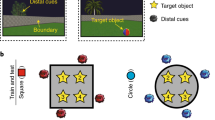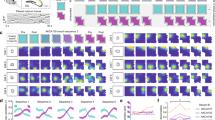Abstract
This paper investigates how noise affects a minimal computational model of the hippocampus and, in particular, region CA3. The architecture and physiology employed are consistent with the known anatomy and physiology of this region. Here, we use computer simulations to demonstrate and quantify the ability of this model to create context codes in sequential learning problems. These context codes are mediated by local context neurons which are analogous to hippocampal place-coding cells. These local context neurons endow the network with many of its problem-solving abilities. Our results show that the network encodes context on its own and then uses context to solve sequence prediction under ambiguous conditions. Noise during learning affects performance, and it also affects the development of context codes. The relationship between noise and performance in a sequence prediction is simple and corresponds to a disruption of local context neuron firing. As noise exceeds the signal, sequence completion and local context neuron firing are both lost. For the parameters investigated, extra learning trials and slower learning rates do not overcome either of the effects of noise. The results are consistent with the important role played, in this hippocampal model, by local context neurons in sequence prediction and for disambiguation across time.
Similar content being viewed by others
References
Abbott LF, Blum KI (1995) Functional significance of long-term potentiation for sequence learning and prediction. Cerebral Cortex, in press
Amaral DG, Witter MP (1989) The three-dimensional organization of the hippocampal formation: a review of anatomical data. Neuro science 31:571–591
Amari S (1971) Characteristics of randomly connected threshold-element networks and network systems. Proc IEEE 59:35–47
Amari S (1972) Learning patterns and pattern sequences by selforganizing nets of threshold elements. IEEE Trans Comput 21:1197–1206
Bartholomeus M, Coolen ACC (1992) Sequences of smoothly correlated patterns in neural networks with random transmission delays. Biol Cybern 67:285–290
Bauer K, Krey U (1990) On learning and recognition of temporal sequences of correlated patterns. Physica B: Condensed Matter 79:461–475
Breese CR, Hampson RE, Deadwyler SA (1989) Hippocampal place cells: stereotypy and plasticity. J Neurosci 9:1097–1111
Buhmann J, Schulten K (1987) Noise-driven temporal association in neural networks. Europhys Lett 4:1205–1209
Cohen MA, Grossberg S (1983) Absolute stability of global pattern formation and parallel memory storage by competitive neural networks. IEEE Trans Systems Man Cybern 815–826
Coolen ACC, Gielen CCAM (1988) Delays in neural networks. Europhys Lett 7:281–285
Eichenbaum H, Buckingham J (1991) Studies on hippocampal processing: experiment, theory, and model. In: Gabriel M, Moore J (eds) Neurocomputation and learning: foundations of adaptive networks. MIT Press, Cambridge, Mass., pp 171–231
Eichenbaum H, Wiener SI, Shapiro ML, Cohen NJ (1989) The organization of spatial coding in the hippocampus: a study of neural ensemble activity. J Neurosci 9:2764–2775
Elman JL (1990) Finding structure in time. Cognit Sci 14:179–211
Fukushima K (1973) A model of associative memory in the brain. Kybernetik 12:58–63
Gluck MA, Myers CE (1993a) Adaptive stimulus representations: a computational theory of hippocampal-region function. In: Hanson SJ, Cowan JD, Giles CL (eds) Advances in neural information processing systems 5. Morgan Kaufmann, San Mateo, Calif, pp 937–944
Gluck MA, Myers CE (1993b) Hippocampal mediation of stimulus representation: a computational theory. Hippocampus 3:491–516
Griniasty M, Tsodyks MV, Amit DJ (1993) Conversion of temporal correlations between stimuli to spatial correlations between attractors. Neural Comput 5:1–17
Hasselmo ME, Schnell E (1994) Laminar selectivity of the cholinergic suppression of synaptic transmission in rat hippocampal region CA1: computational modeling and brain slice physiology. J Neurosci 14:3898–3914
Heskes TM, Gielen S (1992) Retrieval of pattern sequences at variable speeds in a neural network with delays. Neural Networks 5:145–152
Hopfield JJ (1982) Neural networks and physical systems with emergent collective computational abilities. Proc Natl Acad Sci USA 79:2554–2558
Jordan MI (1986) Attractor dynamics and parallelism in a connectionist sequential machine. In: Proceedings of the eighth conference of the Cognitive Science Society. Erlbaum, Hillsdale, NJ, pp 531–546
Kesner RP (1990) Learning and memory in rats with an emphasis on the role of the hippocampal formation. In: Kesner RP, Olton DS (eds) Neurobiology of comparative cognition. Erlbaum, Hillsdale, NJ, pp 179–204
Kesner RP (1991) The role of the hippocampus within an attribute model of memory. Hippocampus 1:279–282
Kesner RP, Hardy JD (1983) Long-term memory for contextual attributes: dissociation of amygdala and hippocampus. Behav Brain Res 8:139–149
Kleinfeld D (1986) Sequential state generation by model neural networks. Proc Natl Acad Sci USA 83:9469–9473
Levy WB (1982) Associative encoding at synapses. In: Proceedings of the fourth annual conference of the Cognitive Science Society, pp 135–136
Levy WB (1985) An information/computation theory of hippocampal function. Soc Neuroci Abstr 11:493
Levy WB (1989) A computational approach to hippocampal function. In: Hawkins RD, Bower GH (eds) Computational models of learning in simple neural systems. Academic Press, New York, pp 243–305
Levy WB (1994) Unification of hippocampal function via computational considerations. World Congress on Neural Networks IV:661–666
Levy WB, Steward O (1983) Temporal contiguity requirements for long-term associative potentiation/depression in the hippocampus. Neuroscience 8:791–797
Levy WB, Wu XB, Baxter RA (1995) Unification of hippocampal functions via computational/encoding considerations. Int J Neural Syst, Supplement: 71–80
Liljenström H, Wu XB (1995) Noise-enhanced performance in a cortical associative memory model. Int J Neural Syst 6:19–29
McNaughton BL, Nadel L (1989) Hebb-Marr networks and the neurobiological representation of action in space. In: Gluck MA, Rumelhart D (eds) Neuroscience and connectionist theory. Erlbaum, Hillsdale, NJ, pp 1–63
Minai AA, Levy WB (1993a) The dynamics of sparse random networks. Biol Cybern 70:177–187
Minai AA, Levy WB (1993b) Predicting complex behavior in sparse asymmetric networks. In: Giles CL, Hanson SJ, Cowen JD (eds) Advances in neural information processing systems. Morgan Kaufmann, San Mateo, Calif, pp 556–563
Minai AA, Levy WB (1993c) Sequence learning in a single trial. World Congress on Neural Networks II:505–508
Minai AA, Levy WB (1994) Setting the activity level in sparse random networks. Neural Comput 6:85–99
Minai AA, Barrows G, Levy WB (1994) Disambiguation of pattern sequences with recurrent networks. World Congress on Neural Networks IV: 176–181
Mozer MC (1989) A focused backpropagation algorithm for temporal pattern recognition. Complex Syst 3:349–381
Muller RU, Kubie JL (1989) The firing of hippocampal place cells predicts the future position of freely moving rats. J Neurosci 9:4101–4110
O'Keefe J, Nadel L (1978) The hippocampus as a cognitive map. Oxford University Press, Oxford
O'Reilly RC, McClelland JL (1994) Hippocampal conjunctive encoding, storage, and recall: avoiding a tradeoff. Hippocampus 4:661–682
Prepscius C, Levy WB (1994) Sequence prediction and cognitive mapping by a biologically plausible neural network. World Congress on Neural Networks IV:164–169
Reiss M, Taylor JG (1991) Storing temporal sequences. Neural Networks 4:773–787
Saypoff R, Muller RU, Kubie JL (1992) How place cells connected by Hebbian synapses can solve spatial problems. Soc Neurosci Abstr 2:1211
Schmajuk N, Thieme A (1992) Purposive behavior and cognitive mapping: a neural network model. Biol Cybern 67:165–174
Sharp PE (1991) Computer simulation of hippocampal place cells. Psychobiology 19:103–115
Sompolinsky H, Kanter I (1986) Temporal association in asymmetric neural networks. Phys Rev Lett 57:2861–2864
Squire LR (1992) Memory and the hippocampus: a synthesis from findings with rats, monkeys, and humans. Psychol Rev 99:195–231
Treves A, Rolls ET (1992) Computational constraints suggest the need for two distinct input systems to the hippocampal CA3 network. Hippocampus 2:189–200
Wu XB, Liljenström H (1994) Regulating the nonlinear dynamics of olfactory cortex. Network: Comput Neural Syst 5:47–60
Author information
Authors and Affiliations
Rights and permissions
About this article
Cite this article
Wu, X., Baxter, R.A. & Levy, W.B. Context codes and the effect of noisy learning on a simplified hippocampal CA3 model. Biol. Cybern. 74, 159–165 (1996). https://doi.org/10.1007/BF00204204
Received:
Accepted:
Issue Date:
DOI: https://doi.org/10.1007/BF00204204




